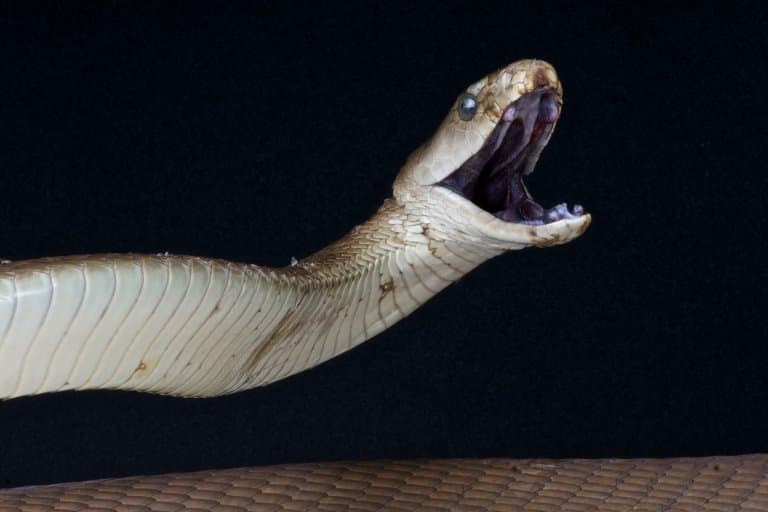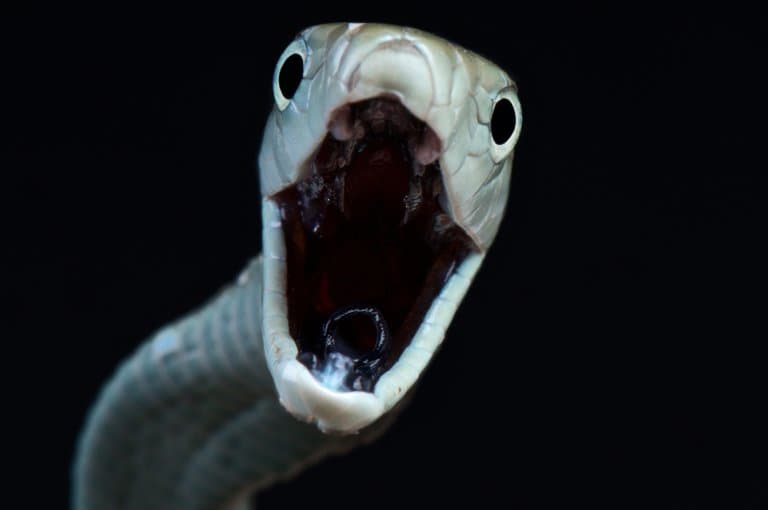Black Mamba Profile
It’s rare that an animal lives up to its Hollywood hype, but in some cases the rumours are true.
The ‘deadliest snake in the world’ does appear to be just as aggressive and damaging as they say it is, and can kill with remarkable efficiency.
Named after the colour of its inky black mouth, the black mamba has a fitting reputation as a deadly and aggressive hunter.

Black Mamba Facts Overview
| Habitat: | Mostly terrestrial, sometimes arboreal: Savanna, woodland, rocky outcrops and forest |
| Location: | Southern, Central and Eastern Sub-Saharan Africa |
| Lifespan: | More than 11 years |
| Size: | Up to 4.5 m |
| Weight: | 3.5 lb (1.6 kg) |
| Color: | Gray |
| Diet: | Small birds, bats, and some larger mammals |
| Predators: | Eagles, crocodiles, some mongooses and honey badgers |
| Top Speed: | Possibly up to 19 kph (12 mph) |
| No. of Species: |
1 |
| Conservation Status: |
Least Concern |
The black mamba is a species of venomous snake from the Elapidae family, which includes 55 genera and around 360 species of snake. They are large, fast, and highly lethal snake with a reputation for being more aggressive than its shy cousins.
They are native to sub-Saharan Africa, inhabiting woodlands, savannahs and rocky outcrops – living in both in trees, and on the ground. They usually live in lairs on the ground such as hollow trees, rock crevices or burrows from which they hunt.
Black mambas are slender and can grow up to 4.5 m (15 ft) in length and are dark brown or gray in color. They have a coffin-shaped head, and can spread their neck hood – and hiss, similar to a cobra.
They mainly feed on birds, small rodents, bats and will eat other snakes. Typically they will bite their prey injecting venom, wait for it to be parazlyzed or death, before swallowing them whole.
They will generally stay away from people where possible, but if threatened will not hesitate to attack, striking multiple times and injecting tens of times the lethal dose of a highly potent complex venom.
If bitten, death within 30 minutes is almost a certainty. The only hope is to get immediate treatment with antivenom – something which is rarely available in the remote habitats of this snake.
Interesting Black Mamba Facts
1. They are not black
In fact, black mambas are brown, olive and gray in color with paler bellies. They are named after the coloration on the inside of their mouths which is a deep inky black.
When threatened, the black mamba will open their mouths and show the black lining as a warning.

2. They are often cited as the most dangerous snake in the world
Black mambas are not one of the most venomous snakes in the world, when considering the potency of a snake’s venom. There are more venomous snakes out there, mostly in Australia.
They are also not one of the deadliest snakes in the world, as they are not responsible for causing the greatest number of medically significant snake bites to humans. These mostly reside in Asia where there’s lots of snakes near people.
However, the black mamba is still cited by experts as the most dangerous snake due to a combination of its size, aggression, and speed. It is the most feared snake in Africa, and the onset of symptoms that can lead to death are believed to be the fastest of any known snake in the world.
Black mambas have a 100% rate of envenomation of their venomous bites, as well – so the likelihood of a ‘dry bite’ is virtually zero. They are able to bite from considerable range and often bite victims multiple times.
The required dose of antivenom to counter the symptoms need to be massive (10-30 vials). Untreated black mamba bites have a mortality rate of 100%.
3. They’re fast!
It’s hard to find a reliably recorded figure for the speed of a black mamba. Possibly because it’s a deadly pursuit to measure one.
The Guinness Book of World Records has it at 19 kph (12 mph) over short distances, but any figure that comes from an organisation specialising in how many melons you can smash with your face in under a minute should be met with healthy scepticism, especially since it’s totally unsourced.
However, mambas are notoriously fast, and certainly one of the fastest snakes on land. They also strike very quickly.
Again, this is something that scientists haven’t wasted their scarce funding on ranking precisely, but it is reasonable to say that black mambas are one of the fastest snakes!
4. They’re the second longest venomous snake in the world
One of the reasons they’re so quick in moving is their sleek, elongated form.
They use this length to propel themselves forward in a coordinated S-shaped serpentine locomotion, and can even hold their heads well up off the ground to see where they’re going.
Mambas are the second-longest venomous snake growing up to 4.5 m (15 ft), after the king cobra that can reach up to 5.59 m (18.3 ft).

5. They have beautiful fights
When two of these long, fast snakes decide they don’t like one another, they engage in a spectacular dance, in which they’ll wrestle one another striving to keep their heads above that of their rival.
This appears to be a test of strength and agility, rather than a fight to the death and they rarely bite one another.
Even if they did bite, it may have no effect. It’s thought that mambas are immune to the effects of their own and similar venoms, as are some of their top predators like the honey badger and mongoose.
And that’s fortunate because the venom is exceptional. 1
6. They have the longest fangs of any elapid
They grow between 0.5 – 1 inch in length and they are positioned far forwards in the mouth in the upper jaw.
Their fangs are hollowed and which allows the snake to deliver their neurotoxic venom. They have flexible jaws that can dislocate to accommodate food up to four times the size of their head.
7. They’re extremely venomous
It’s said that it only takes 2 drops of black mamba venom to kill a person. This totally ambiguous unit of measurement is clarified elsewhere as around 10 to 15mg.
This is about the amount of salt in half a cup of iceberg lettuce, for what it’s worth, and a small fraction of the 400mg the snake can inject in a single attack, which may involve a series of frenzied bites.
The venom delivery system is commonly said to be the most advanced of any snake on the planet but this claim is never followed up with any mention of what that actually means.
Still, it’s venomous enough. 2

8. The venom is complex
Their venom is made up of a diverse mixture of small proteins, most of which are incredibly fast-acting toxins.
One class of toxins found in this venom is so unique to mambas it’s named after them: dendrotoxins quickly affect the nerves and cause central neurotoxicity.
There are other components, but these neurotoxins are the ones you need to pay attention to at first. 3
9. They can paralyse you
The venom interferes with nervous transmission between the muscles and nerves, essentially disconnecting them and paralysing the victim.
Then, cardio-toxic compounds will quickly get to work on the heart, ultimately shutting it down.
When a person is bitten, the site of the injection will swell slightly and hurt somewhat. This venom isn’t designed to cause a lot of pain; instead, it’s more insidious.
Dizziness will follow, and miscoordination of the face and tongue, slurred speech and blurry vision will come soon after.
Within 20 to 45 minutes, paralysis and death are likely.
Black mamba bites are almost 100% fatal without antivenom, but it’s recommended that a tight binding tourniquet is used on the site of the bite while the victim is taken to the hospital. 4
10. So, why does it need to be so dangerous just to eat birds?
The mamba’s main prey items are small birds and bats. Essentially, vertebrates. They will sometimes tackle something larger, like a rock hyrax, but primarily they’re going to be looking for a thing that will more easily fit in their mouths.
There are a few reasons to have very potent venom. In snakes, terrestrial species like the black mamba tend to have more potent venom than their arboreal cousins. This might be due to being more exposed to predators or having fewer opportunities to catch prey, and so needing to be extra potent to exploit rarer opportunities.
Some snakes may need to disable prey quickly, either to avoid a death struggle that could harm the snake, or draw attention to the altercation from animals who might try to steal the meal.
For this reason, they want a fast-acting and efficient venom that knocks out a vertebrate quickly.
Venoms are complex and diverse, and there’s still a huge amount to learn from them. Researchers are still trying to piece together why some animals are just that much more deadly than others. 5

11. A better painkiller the morphine
Even the black mamba’s terrifying venom has some positives to it.
Being a complex cocktail of compounds, there are some elements in the venom that aren’t deadly and may have useful properties.
Scientists are now looking into a specific compound in mamba venom that may be applied as a non-addictive painkiller. 6
12. There are other mambas
Their genus Dendroaspis, includes 3 other mambas, the eastern green mamba, jameson’s mamba and western green mamba. Like two of their names suggest, they are all green in color.
While all species of mamba are venomous and native to Africa, these three snakes are all arboreal, meaning they live in trees – and considerably less deadly than the black mamba.
13. They have few enemies, but do have a nemesis
The moongoose is a notorious snake killer, with razor-sharp teeth and lightning speed and agility.
It has evolved immunity to the black mambas venom, meaning they can dance circles around a black mamba before attacking and killing the snake.
Black Mamba Fact-File Summary
Scientific Classification
| Kingdom: | Animalia |
| Phylum: | Chordata |
| Class: | Reptilia |
| Order: | Squamata |
| Family: | Elapidae |
| Genus: | Dendroaspis |
| Species Name: |
Dendroaspis Polylepis |
Fact Sources & References
- “Black mamba“, National Geographic.
- Brandon Cornett (2019), “Black Mamba: The World’s Fastest Snake Also Has a Fast Strike“, Reptile Knowledge.
- Petras, Daniel; Heiss, Paul; Harrison, Robert A.; Süssmuth, Roderich D.; Calvete, Juan J. (2016), “Top-down venomics of the East African green mamba, Dendroaspis angusticeps, and the black mamba, Dendroaspis polylepis, highlight the complexity of their toxin arsenals“, Journal of Proteomics.
- Phoebe Roth (2019), “Why knowing what black mamba venom does to the human body is crucial“, The Conversation Trust.
- Chrissy Sexton (2019), “Why is the venom of some snakes so much more dangerous than others?“, Earth.com.
- James Gallagher (2012), “Black mamba venom is ‘better painkiller’ than morphine“, BBC.
